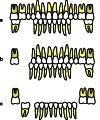Functional dental status and oral health-related quality of life in an over 40 years old Chinese population
- PMID: 23015025
- PMCID: PMC3691481
- DOI: 10.1007/s00784-012-0834-x
Functional dental status and oral health-related quality of life in an over 40 years old Chinese population
Abstract
Objectives: This study aimed to assess oral health-related quality of life (OHRQoL) related to dental status.
Material and methods: One thousand four hundred sixty-two Chinese subjects over 40 years, dentate in both jaws, were categorized in a hierarchical functional classification system with and without tooth replacements. OHIP-14CN scores were used to assess OHRQoL and analyzed using multivariable logistic regression including five dental conditions ('≥10 teeth in each jaw'; 'complete anterior regions'; 'sufficient premolar regions' (≥3 posterior occluding pairs (POPs)); 'sufficient molar regions' (bilaterally ≥1 POP); and tooth replacement) after adjustment for five background variables. Likelihood ratios for impaired OHRQoL (OHIP total score ≥5) were assessed at each level of the classification system.
Results: In the hierarchical scheme, OHIP-14CN total scores were highest in branch '<10 teeth in each jaw' (8.5 ± 9.5 to 12.3 ± 13.2). In branch '≥10 teeth' scores ranged from 6.2 ± 7.7 to 8.3 ± 9.3. The most important dental condition discriminating for impact on OHRQoL was '≥10 teeth in each jaw' (Likelihood ratio 1.59). In this branch subsequent levels were discriminative for impaired OHRQoL (Likelihoods 1.29-1.69), in the branch '<10 teeth in each jaw' they were not (Likelihoods 0.99-1.04). Tooth replacements were perceived poorer as their natural counterparts (odd ratios, 1.30 for fixed and 1.47 for removable appliances).
Conclusions: OHRQoL was strongly associated with the presence of at least 10 teeth in each jaw. The hierarchical classification system predicted approximately 60 % of subjects correctly with respect to impaired OHRQoL.
Clinical relevance: From an OHRQoL perspective, natural teeth were preferred over artificial teeth.
Figures


References
-
- Nguyen TC, Witter DJ, Bronkhorst EM, Pham LH, Creugers NHJ. Dental functional status in a Southern Vietnamese adult population—an analysis by a combined quantitative and qualitative classification system analysis. Int J Prosthodont. 2011;24:30–37. - PubMed
-
- Zhang Q, Kreulen CM, Witter DJ, Creugers NHJ. Oral health status and prosthodontic conditions of Chinese adults: a systematic review. Int J Prosthodont. 2007;20:567–572. - PubMed
MeSH terms
LinkOut - more resources
Full Text Sources
Medical

